The Language of Music, and Vice Versa
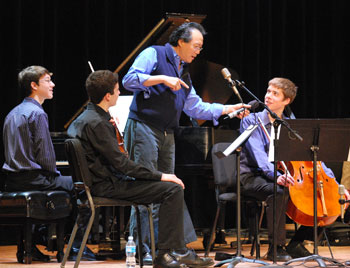
Yo-Yo Ma asks a question of Eric Tinkerhess, a cellist from Community High School, during a master class session at Hill Auditorium on Saturday. On piano is J Bennett, and Jacob Joyce was playing violin. The three teens form the Trio Animando. (Image links to larger version.)
Oftentimes here at The Chronicle we cover wildly different events within the span of a few hours. And equally often, it ends up that seemingly different things – like classical music and a language competition – have all sorts of connections we never imagined.
And so it was on Saturday, when we observed first a master class taught by cellist Yo-Yo Ma and the Silk Road Ensemble at Hill Auditorium, followed by a statewide Japanese Quiz Bowl at the University of Michigan Modern Languages Building, just behind Hill. Both events were attended by several hundred people, and both had communication at their core.
But only one of them talked about vomit, and that’s where we’ll begin.
“Channeling crazy”
Yo-Yo Ma and the Silk Road Ensemble were in Ann Arbor this weekend for two performances, on Friday and Saturday nights. But they also spent two hours on Saturday giving a free performance and master class, working with a trio of Pioneer and Community high school musicians as well as an ensemble from the UM School of Music. The event was coordinated by the University Musical Society‘s education department.
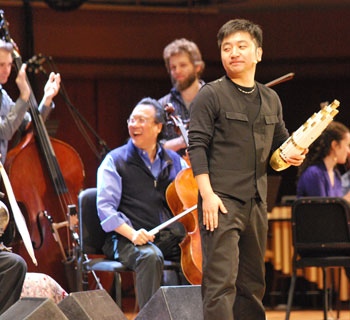
Wu Tong, a member of the Silk Road Ensemble, listens to applause for his solo performance on Saturday morning.
The program began with two stunning Silk Road performances. First, Wu Tong played a solo on the sheng, a traditional Chinese reed instrument. The song was at turns soulful and rambunctious, and later Ma told the audience that this was the first time the Silk Road performers had heard this piece. “It’s just mesmerizing,” he said.
The entire group then joined Azerbaijani singer Alim Qasimov and his daughter, Fargana Qasimova, in a richly textured piece from the opera ”Layla and Majnun.” [The New York Times describes this work in a Feb. 27, 2009 article here.]
But the main part of the two-hour session focused on students, beginning with a trio from Pioneer and Community high schools.
When introducing the trio, Joe Gramley – a UM assistant professor who is also a member of the Silk Road Ensemble – talked briefly about how music was a form of communication, a theme that echoed throughout the event.
Jacob Joyce, J Bennett and Eric Tinkerhess – the Trio Animando – performed a portion of Dmitri Shostakovich’s Piano Trio No. 2 in e minor, Op. 67 (II. Allegro non troppo). “Wow,” said Ma, as the applause faded following their performance. “That’s all we have to say. Wow.”
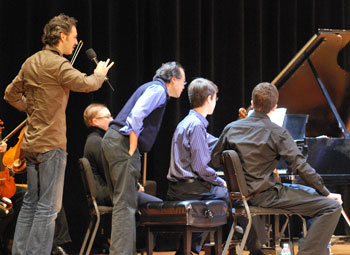
Colin Jacobsen, a violinist with the Silk Road Ensemble, and Yo-Yo Ma give students J Bennett (on piano) and Jacob Joyce (on violin) some advice about their performance.
It turns out that wasn’t quite all he had to say, and for the next 30 minutes or so he and some other members of the Silk Road Ensemble pushed the three younger musicians to take their music to a much crazier place.
This is where the vomit comes in.
When asked to describe what the piece meant to him, Eric Tinkerhess said “craziness.” Why crazy? Because Shostakovich had composed the music during World War II, as a tribute to a friend who died in a Nazi concentration camp. It’s a powerful piece, and Tinkerhess said he tried to play it “like a madman.”
Colin Jacobsen, a violinist with the ensemble, said that when channeling craziness, you have to be very specific in how you’re playing crazy. He recalled how he once performed the same piece for an audience that included a friend of the composer, who afterward told him that this particular part of the piece was “like vomiting.”

Part of the audience at Hill Auditorium on Saturday before the master class with Yo-Yo Ma and the Silk Road Ensemble.
Describing the performance of Trio Animando, Jacobsen said, “It sounded a little vomity, but I think it could be wildly exaggerated.”
After the trio played that section again, Yo-Yo Ma picked up on the visceral aspect, saying their performance should feel physically awkward, lurching – and as they played yet again, Ma walked among them making loud and quite realistic sounds of someone hurling. They’re trying to achieve a “group vomit,” he said later. “It’s hard to do.”
Ma described the need to have a “toolkit of craziness – sometimes it’s a tank division, sometimes it’s the bones rattling.”
He also playfully teased the teens, prompting Tinkerhess to talk about what “Breakin’ Curfew” meant to him. “Rebelliousness,” he said. And … well, let’s just say that sitting in front of a crowd of strangers, family and friends, it’s hard to describe too vividly just exactly how “rebelliousness” takes place.
The second portion of the master class focused on a UM School of Music Ensemble: Sarah Frisof on flute, Jean-hee Lee on violin, Nicholas Hancox on viola, Sam Livingston on percussion, and Nick Finch on cello. They played “Encaenia” by Paul Dooley, who’s working on his masters of music at UM. The Chronicle was unable to stay for this portion of the event, however, as we were off to observe a different kind of communication take place.
“I heard you say no, but you’re gonna learn anyway”
By the time we arrived at the 2009 Japanese Quiz Bowl next door, the morning’s preliminary competition had ended and a few hundred students, parents and others packed the large lecture hall awaiting the finals. For 16 years, this annual event – hosted by the UM Center for Japanese Studies and Japanese Teachers Association of Michigan – has highlighted the language and culture of Japan. For the Japanese language learning community, this is a very big deal.
It’s a marketing opportunity, too: In the hallway outside the lecture hall, tables were set up selling all sorts of Japanese food, clothing and other items. Wizzywig, an Ann Arbor store located on South State, was there with Pokemon figures, stuffed animals, keychains, Hello Panda cookies and more.
Another vendor had a selection of T-shirts – one featuring what looked like a beefy sumo wrestler, another with the phrase “Japanese, please!” (in Japanese, of course).
There’s a frenetic energy in a room full of kids amped up for competition, and things were running a little late. To kill some time, one of the organizers – who told the crowd he taught Japanese to kindergartners – asked if they wanted to sing a song. Several people shouted, “No!” which prompted him to say, “I heard you say no, but you’re gonna learn anyway.” And so he led the audience in a song about the sounds that animals make, perhaps a Japanese version of “Old MacDonald.” At least that’s our best guess.
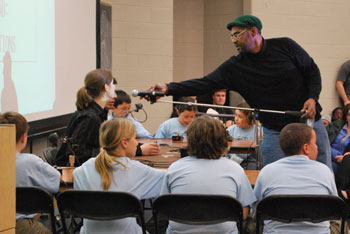
Two teams from Emerson School in Ann Arbor get ready to face off during the elementary finals at the 2009 Japanese Quiz Bowl. But first, a sound check.
As this was happening, others were setting up the microphones and buzzer system used during the finals (QuizMachine was the mechanism of choice). The buzzers emitted a brittle electronic yap with an accompanying light, which seemed slightly unsatisfying but certainly sufficient to identify the person who buzzed in.
Finally, the first two teams were called to the front, each with four members, all eight from Emerson School in Ann Arbor, all eight wearing light blue T-shirts with a big white E on the front.
Though one of the organizers had told the audience, sharply, that they were not to take photos or notes or to record the proceedings in any way, on pain of having their entire school disqualified next year, no one seemed to care that The Chronicle was both taking photographs and copious notes.
Among the things we noted were the rules:
- Team captains play the Japanese equivalent of Rock/Paper/Scissors to determine which team goes first in the team consultation round.
- In the consultation round, teams are given 30 seconds to come up with the answer, which is given by the team captain. If they’re wrong, the other team gets a chance to answer.
- During the toss-up phase, anyone can buzz in. If you answer incorrectly, anyone from the opposing team gets a chance.
- The final portion of the quiz – visual questions – is a variation of the toss-up phase, with questions related to visual prompts projected onto a screen.
As one of the organizers said, “It’s all very exciting.”
So what kinds of questions were these elementary students asked? We’d love to tell you, but we’re afraid of disqualifying our team next year, should we in fact decide to start a Japanese language school. You never know.
However, we can safely say that one of the Emerson teams won the match – we hope to report all local winners in the comment thread when we get the results. In addition to Emerson, the Ohara Language School in Ann Arbor had a large contingent competing, with students who attend Clague and Tappan middle schools, and Saline and Pioneer high schools.
We could only stay for one round, but this story doesn’t end there.
As we exited the Modern Languages Building, we noticed two of the members of the Trio Animando – Tinkerhess and Bennett – being interviewed by a reporter and photographer from Community High School’s student publication, The Communicator. We look forward to reading their report.
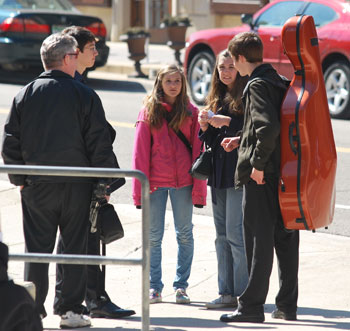
A reporter and photographer from the Community High School student newspaper, The Communicator, interview Eric Tinkerhess (right) and J Bennett (second from left), two of the three members of Trio Animando.
But the story doesn’t quite end there, either.
As we walked around the back of Hill Auditorium, members of the Silk Road Ensemble were emerging from the back entrance. And there was Yo-Yo Ma.
Had we been more communicative, we might have asked him what was in the blue folder he held. Or where he was headed – off to lunch? Back to his hotel room for a nap? But no, we merely watched as he bid farewell to his companion and started walking north on Thayer. Solo.







Yo-Yo
What a wonderful story about a beautiful man that understands that he will be defined not only by what he accomplishes, but by what he inspires in others.
~Stew
The master classes by professional musicians (which memebers of the New York Philharmonic participated in last week) are one of those amazing things about living in Ann Arbor. The generosity of many performers over the years is amazing.
Hey Chronicle – help! How about having spellcheck for us bumblers??? :-)
(members it is)
we are proud of you cousin
love
from Israel
chaggit
I’m the pianist in the trio Animando. The masterclass was one of the best experiences in my life. There’s nothing else I can really say. It was awesome.